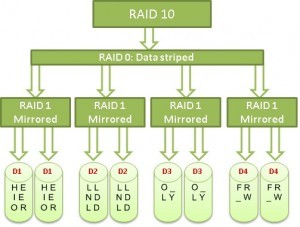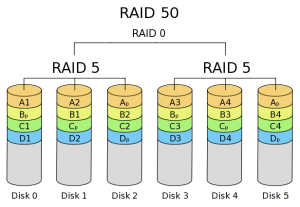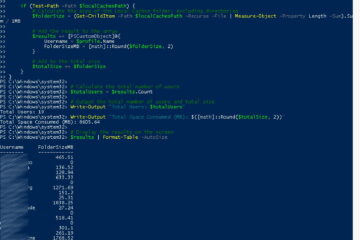To understand RAID (Redundant Array of Independent Disks) 10 and RAID 50 you need to have a basic understanding of RAID 0, RAID 1 and RAID 5 (get it… 5+0 = 50) which are easy to explain:
RAID 0 is “stripping”:
Take two or more disks and connect them like they are a single large disk. If any of the disks fail, you loose everything on all the disks.
RAID 1 is “mirroring”:
Take two disks and that are being written to with the same information at the same time… like a mirror image, so if one fails, you loose nothing.
RAID 5 is “stripping with parity”:
Stripe (like RAID0) a pile of disks (minimum 3) BUT also add in a check digit so that if a disk fails, the missing data can be calculated but the RAID controller. In this condition, your RAID is called “degraded” because it is still working but the controller is working like crazy to calculate the missing data as you request it. If you swap out the failed disk for a new disk, the RAID controller will calculate all of the missing data and write it to the new disk. From that point on you are back to normal business and RAID controller only has to calculate  a parity bit when someone writes data to the array (as opposed to every time someone tries to read data from the array)
a parity bit when someone writes data to the array (as opposed to every time someone tries to read data from the array)
RAID 10 is “RAID 1 + RAID 0”:
RAID 10 is simply a bunch of Mirrors stripped together which makes them fast and pretty reliable, but you are burning off half of your disks (because they are mirrored)
RAID 50 is “RAID 5 + RAID 0”:
RAID 50 is the best of all worlds today for most corporate use: Take a large set of disks (lets say 20 disks), split them into to two piles. Configure each sets of 10 disks to be run as RAID 5, then stripe the two together. This means your 20 disks effectively becomes 18 usable disks because each of the two RAID5’s uses the equivalent of one disk for “parity”. The graphic to the right shows the smallest RAID 50 possible, which contains only 6 disks.
What about Hot Spares?
A Hot Spare is a disk that is NOT in use by the array but is just sitting waiting for a disk to fail. In the event of a disk failure, the RAID controller will shut down the failed disk, spin up the hot spare and start recalculating the missing data (using PARITY from RAID 5, or just simply cloning the disk if you are using RAID 1).
For example, you may look at a Dell Equallogics (or any other brand) array and see 24 disks configured as RAID 50 but only the equivalent of 20 disks usable space and ask yourself ‘how can that be’? Well, most manufactures run their RAID5 and RAID50 with a hot spare, which means that each of your two RAID5’s also has a disk set aside by the hardware which will be automatically engaged if the system detects a failed disk. This is a very good thing for reliability this but:
- if you are running a RAID 5 you are losing 2 disks (1 hot spare + 1 “parity” disk) and
- if you are using RAID 50 you are now loosing 4 disks (2 hot spares + 2 “parity” disks)
The short video below will help explain this if you are still having problems wrapping your head around these concepts:
Thanks to the following sites for their information:
http://psonlinehelp.dell.com/en/V8.0/GUID-03B3D98B-54A7-403B-B3C0-B59324C8E08A.html
http://blog.iweb.com/en/2010/05/an-overview-of-raid-technology/4283.html
http://www.grrr.co.za/content.php?123-Introduction-to-all-things-RAID



1 Comment
URL · October 28, 2020 at 4:37 pm
… [Trackback]
[…] Read More: urtech.ca/2015/09/solved-what-are-raid-10-and-raid-50-in-simple-terms/ […]